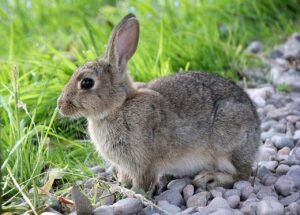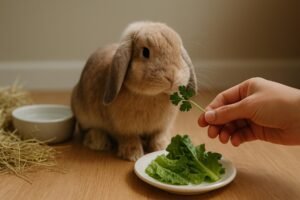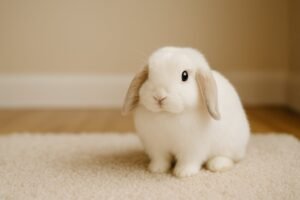As rabbit owners, we understand the importance of providing our furry friends with a comfortable and clean living environment. A crucial aspect of rabbit care is setting up the perfect litter box. But what do you put in a rabbit litter box, and how can we ensure it meets their needs? Let’s dive in and explore the world of rabbit litter boxes together!
Key Takeaways
Select the ideal litter box for your rabbit, considering factors such as size, accessibility and material.
Choose safe and effective options like paper-based bedding or wood-based pelleted litter to avoid potentially harmful materials.
Set up the box with newspaper and hay if desired. Maintain cleanliness by regularly cleaning & using odor-absorbing litter.
Selecting the Ideal Litter Box for Your Rabbit

Several factors such as size, accessibility, and material should be considered while choosing a litter box for your rabbit. Here are some tips to help you make the right choice:
Choose a large-sized litter box to ensure your rabbit has enough space for their business.
For rabbits weighing more than 10 lb (4.5 kg) or if you have more than one rabbit, a giant-sized litter box is recommended.
Select a litter box that is easy to access for your rabbit.
Consider the material of the litter box. Plastic litter boxes are easy to clean and durable.
Avoid litter boxes with high sides as they may make it difficult for your rabbit to enter and exit.
Cat litter boxes are generally recommended for rabbits as they are designed with the right size and accessibility for rabbits.
Choosing the right bunny’s litter box for your rabbit is important to ensure their comfort and hygiene, especially when selecting a clay litter. Clean litter boxes are essential for maintaining a healthy environment for your pet, and using fresh litter in their litter tray can help achieve this goal.
The size of the litter box isn’t the only factor to consider when choosing the ideal option. Rabbits need a comfortable and easy-to-access space in their litter boxes. For example, larger rabbits or older rabbits may require a litter box with a lower entry point for easier access. Different types of litter and bedding that ensure your rabbit’s comfort and health will be explored further.
The Perfect Rabbit Litter: Top Choices
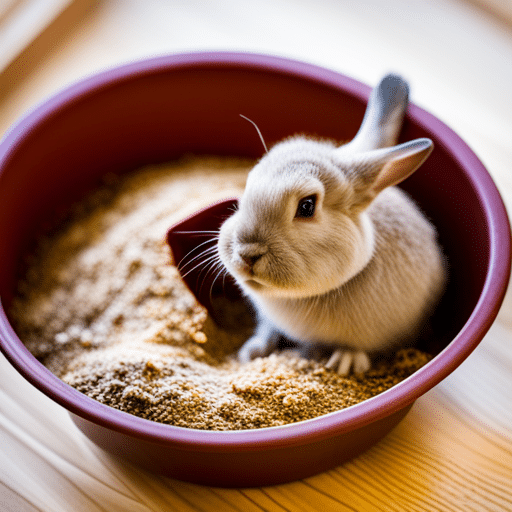
Keeping your rabbit’s environment clean and odor-free significantly depends on the rabbit litter. The top choices for rabbit litter include paper-based bedding, wood-based pelleted litter, and aspen wood shavings. The following sections will discuss the benefits and drawbacks of each option.
Paper-Based Bedding
Paper-based bedding is a safe and effective option for your rabbit’s litter box, but it can be challenging to clean and may create a mess when your rabbit is eating hay in the litter box. Small Pet Select Soft Paper Bedding is recommended for rabbits, as it helps control rabbit urine odors. This bedding is made from 100% unbleached virgin fiber, free from additives, dyes, irritants, and baking soda.
Paper-based bedding, however, has some downsides. As it absorbs urine, it can become heavy and wet, making it more difficult to clean. This can also lead to odor buildup if not changed regularly. Despite these drawbacks, recycled paper litter, a type of paper-based bedding, remains a popular choice for rabbit litter due to its safety and effectiveness.
Wood-Based Pelleted Litter
Wood-based pelleted litter is another safe option for rabbits, commonly used in the form of horse stall pellets and wood stove pellets. When properly maintained, wood-based pelleted litter provides a clean and comfortable environment for your rabbit. However, if not cleaned regularly, it can lead to the formation of sawdust when wet, which can cause respiratory issues.
Completely changing wood-based pelleted litter at least every two weeks is essential to avoid sawdust formation. This helps maintain a clean and healthy environment for your rabbit while reducing the risk of respiratory problems.
Remember to choose wood-based pellets made from safe materials, such as aspen or hardwoods like birch, maple, and beech, and avoid pine and cedar shavings.
Aspen Wood Shavings
Aspen wood shavings are a safe and cost-effective option for rabbit litter. They can be easily found at feed and pet stores at a reasonable price, making them a popular choice for many rabbit owners. However, aspen shavings have a lower absorbency compared to other options, requiring more frequent cleaning.
Using other types of wood shavings, such as pine or cedar, can present health risks for your rabbit. These types of wood contain aromatic oils and chemicals that can be toxic to rabbits, potentially leading to liver complications, respiratory problems, and even liver damage. To keep your rabbit safe and healthy, it is best to stick with aspen wood shavings.
Litter Options to Avoid for Your Rabbit’s Health

While there are many great options for rabbit litter, some choices can be detrimental to your rabbit’s health. Here are some types of litter to avoid:
Cedar shavings: can cause respiratory issues in rabbits
Clumping litter: when ingested, can lead to serious health issues such as intestinal blockages
Scented litter: may seem like a pleasant option for odor control, but it can cause respiratory problems for your rabbit
Hence, choosing a safe and effective litter option for your rabbit like paper-based bedding, wood-based pelleted litter, or aspen wood shavings is crucial. By avoiding potentially harmful litter options, you can keep your rabbit healthy and happy.
How to Properly Set Up Your Rabbit’s Litter Box
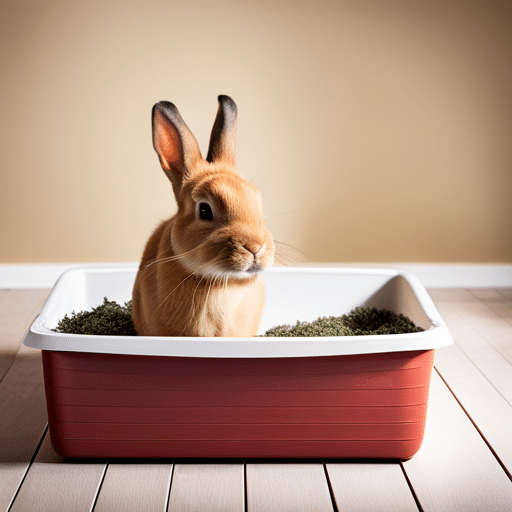
A few simple steps are involved in setting up your rabbit’s litter box correctly. Here’s how:
Choose the right litter to suit your rabbit’s needs, as discussed in previous sections.
Line the litter box with newspaper.
Add a layer of litter that is approximately 0.5 inches thick in the rabbit’s litter box.
Consider placing the litter box on one side or corner of the enclosure for easy access.
In addition to the basic setup, consider adding hay to your rabbit’s litter box. Hay is an essential part of a rabbit’s diet and can also encourage healthy litter habits. You can place hay directly in the litter box or use a hay rack next to the litter box for easy access.
Litter Training Your Rabbit: Tips and Techniques
With a little patience, consistency, and positive reinforcement, litter training your rabbit can become a rewarding experience. To start, follow these steps:
Place a litter box where your rabbit prefers to relieve itself and provide a designated area for droppings.
Establish a routine by consistently placing your rabbit in the litter box after meals and naps.
Use positive reinforcement, such as treats or praise, when your rabbit uses the litter box correctly.
Clean the litter box regularly to maintain cleanliness and encourage your rabbit to continue using it.
Spaying or neutering your rabbit is also crucial for litter training, as it reduces marking behavior and increases the likelihood of them using their litter box.
By following these steps and being patient with your rabbit, you can successfully litter train them, mastering the art of litter training rabbits.
When your rabbit successfully uses the litter box for the first time, offer praise and a preferred treat. If your rabbit begins to urinate outside of its litter box, consult your veterinarian to investigate a potential bladder infection. Remember to be patient and consistent in your efforts, and your rabbit will eventually develop good litter habits.
Maintaining a Clean and Odor-Free Litter Box
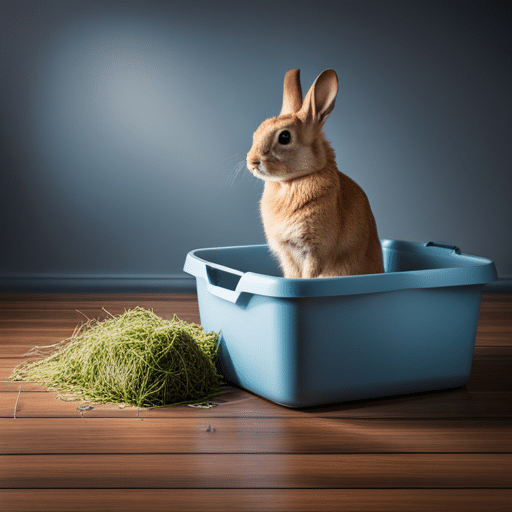
Odor control and monitoring your rabbit’s health require regular cleaning and maintenance of your rabbit’s litter box. To clean the litter box, you can use a pet-safe cleaner, such as Puracy cleaning spray, or a solution of equal parts water and vinegar. Dispose of the used rabbit litter by either throwing it in the trash or composting it if you have the necessary equipment at home.
To keep the litter box smelling fresh, clean it frequently and use odor-absorbing litter. Adequate ventilation is also crucial for minimizing odors. By maintaining a clean and odor-free litter box, you create a pleasant environment for both you and your rabbit.
Hay in the Litter Box: Pros and Cons
Including hay in your rabbit’s litter box can encourage good litter habits and provide a comfortable environment for them. However, it is essential to remove soiled hay daily to prevent spoilage and maintain a clean litter box. If you prefer not to include hay directly in the litter box, an alternative is placing a hay rack adjacent to the rabbit’s litter box.
Whether you choose to incorporate hay directly in the litter box or use a separate hay rack, providing fresh hay is crucial for your rabbit’s digestive health. By keeping hay clean and readily available, you ensure your rabbit’s comfort and well-being.
Customizing Your Rabbit’s Litter Box Setup
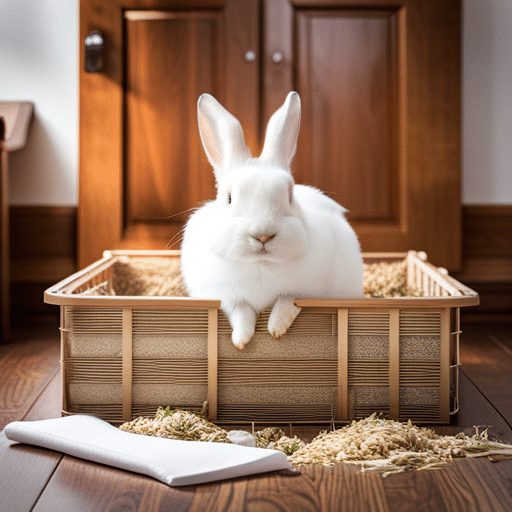
Consider customizing their litter box setup to accommodate your rabbit’s individual preferences and needs. Some popular customization options include:
Selecting a specific type of litter
Incorporating a litter box cover or hood
Utilizing a litter box mat or tray
Opting for a litter box with high sides or a grate
Adding a litter box hay feeder attachment
For example, if your rabbit has a habit of kicking litter out of the box, you may want to consider a high-sided or covered litter box to contain the mess.
Take note of your rabbit’s behavior and preferences to determine the best customizations for their litter box setup. A comfortable and tailored litter box environment can significantly improve your rabbit’s overall happiness and well-being.
Troubleshooting Common Litter Box Issues
Your rabbit may experience some common litter box issues like litter being kicked out of the box or urination outside the box. To address these problems, you can try practical solutions and adjustments to your rabbit’s litter box setup. For example, if your rabbit has a habit of urinating over the edge of the litter box, ensure the sides of the box are high enough to prevent this behavior.
If your rabbit tends to kick litter out of the rabbit’s box, you may want to consider a covered litter box, like the Ware Scatterless Rabbit Litter Box or the Kaytee Long John Rabbit Litter Box, to minimize mess. By addressing these common issues, you can create a cleaner and more comfortable environment for your rabbit.
Summary
In conclusion, setting up and maintaining the perfect rabbit litter box involves selecting the right box, choosing a suitable litter, and properly cleaning and maintaining the environment. By providing your rabbit with a comfortable and clean litter box setup, you contribute to their overall health and happiness. With patience, consistency, and a bit of customization, you can create the ideal litter box environment for your furry friend, ensuring they thrive in their cozy home.
Frequently Asked Questions
What do you put in the bottom of a rabbit litter box?
Fill the bottom of the rabbit litter box with a layer of rabbit-safe pet bedding such as CareFresh, two to three inches deep. Add a thick layer of hay at one end of the litter box or in a hay feeder close enough for your rabbit to munch while still in the box. Pine and cedar shavings should be avoided.
How do you prepare a litter box for a rabbit?
To prepare a litter box for a rabbit, use litter made from aspen shavings or recycled paper, not pine or cedar shavings. Place the litter box in your rabbit’s preferred bathroom area and add one inch of CareFresh bedding and a handful of fresh hay. Wipe out the box before adding the litter and hay, and always use fresh litter and hay for best results.
What is the ideal size for a rabbit litter box?
For most rabbits, a large-sized litter pan is recommended. For rabbits over 10 lb (4.5 kg) or multiple rabbits, a giant-sized litter box is ideal.
Can I use cedar shavings in my rabbit’s litter box?
It is not recommended to use cedar shavings in your rabbit’s litter box, as they can cause respiratory issues.
How often should I clean my rabbit’s litter box?
It is essential to clean your rabbit’s litter box regularly for odor control and health monitoring. Change wood-based pelleted litter completely at least every two weeks.

